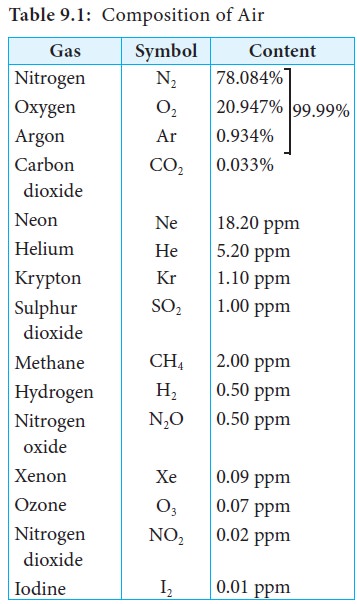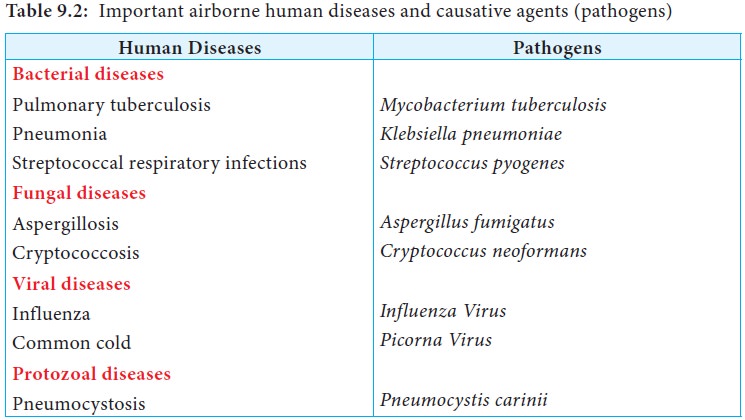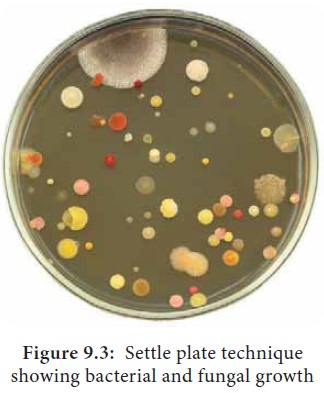Chapter: 11th Microbiology : Chapter 9 : Environmental Microbiology
Air Microbiology
Air Microbiology
Earth’s environment is endowed with atmosphere, hydrosphere, lithosphere and biosphere. In the 1930s, F.C. Meier coined the term “Aerobiology”. Air is a natural resource and is fundamental to human life as it makes breathing possible. Its universal presence and requirement for the survival of human beings make air an important environmental factor. Air contains significant number of microorganisms. It also acts as a medium for the transmission of microorganisms including bacteria, viruses,fungi,yeastandprotozoa.Airborne transmission is one of the important modes for the transmission of infectious diseases. Aeromicrobiology is the study of air borne microorganisms.
Layers of Atmosphere
Earth’s atmosphere is divided into five major layers (Figure
9.1) they are:
• Exosphere : 700 to 10,000 km
• Thermosphere : 80 to 700 km
• Mesosphere : 50 to 80 km
• Stratosphere : 12 to 50 km
• Troposphere : 0 to 12 km

The air in the troposphere, the layer close to the earth is
constantly in motion and the temperature decreases with increasing altitude,
reaching a low of -57°C at the apex of this region.
Microorganisms are frequently found in the lower portion of the troposphere, where they are dispersed by the air currents. Most of the microbes present in the troposphere are either spore formers or microbes that are easily dispersed in air. The stratosphere has a temperature range of -80°C to -10°C. The temperature in the stratosphere can reach a maximum of several thousand degrees. Microorganisms are not found in the upper regions of the atmosphere because of the temperature extremes, scarcity of available oxygen, absence of nutrients and moisture, and low atmospheric pressure. The relatively low humidity in the atmosphere (especially during daylight hours) and UV rays from the sun, limit the types and number of microorganisms that are able to survive in this part of the biosphere.
Composition of Air
The air in our atmosphere is composed of different gaseous
molecules. The most common gases are nitrogen (78%), CO2 (0.034%)
oxygen (21%) argon (1%) and other molecules in trace level are present in the
atmosphere.

Microflora of Air
Human beings and animals are continuously inhaling the microbes
present in the air that cause various infectious diseases. Most of the
respiratory tract infections are acquired by inhaling the air pathogen. The
microflora of air is studied under two categories such as indoor and outdoor
microflora.
Indoor microflora
The air found inside the closed environment (building/ room) is
referred as indoor air and the microbes present in this region is called indoor
microflora.
Example: Staphylococcus,
Bacillus, Penicillium.
Outdoor Microflora
The air in the exterior environment is called outdoor air and
the microbes that reside there are called outdoor microflora.
Example: Bacillus, Aspergillus.
Sources of Microorganisms in Air
Air is not a natural environment for microorganisms as it
doesn’t contain enough moisture and nutrients to support their growth and
reproduction. Soil microorganisms when disturbed by the blow of wind, gets
liberated into air and remain suspended there for a long period.
Man-made actions like digging, ploughing the soil may also release
soil borne microbes into the air. Microorganisms found in water may also enter
air by wind action or tidal action in the form of droplets or aerosols. Air
currents may bring the microorganism from plant or animal surfaces into air.
Commensal as well as pathogenic flora of the human beings may
enter the air by activities like coughing, sneezing, talking and laughing. The
microorganisms are discharged out in different forms of particles which are
grouped on the basis of their relative size and moisture content. These are
aerosols, droplets, droplet nuclei and infectious dust.
Aerosols
An aerosols are mixture of small liquid or solid particles
dispresed in air. Aerosols can be natural or anthropogenic. Example: Dust and
smoke.
Droplets
Droplets are formed by sneezing, coughing and talking which
consists of saliva and mucus (Figure 9.2). Droplets are relatively large, about 10μm or
more in size, and they tend to settle rapidly in still air. When inhaled these
droplets are trapped on the moist surfaces of the respiratory tract. Thus, the
droplets containing pathogenic microorganisms may be a source of infectious disease.

Droplet nuclei
Small droplets in a warm, dry atmosphere tend to evaporate
rapidly and become droplet nuclei. These are 1-4μm in size. They can remain in
air for longer period and transmit various infectious airborne diseases.
Infectious Dust
Large aerosol droplets settle out rapidly from air on to various
surfaces and get dried. Nasal and throat discharges from patient can also
contaminate surfaces and become dry. Microorganisms can survive for longer
period in dust. This creates a significant hazard, especially in hospital
areas.
Air Borne Diseases
Many microbial diseases are transmitted through the air (Table
9.2). The incidence of diseases caused by airborne transmission can be reduced
by covering one’s nose and mouth during coughing or sneezing and by the use of
face masks.

Nosocomial infection
Hospital acquired infection are also known as a nosocomial
infection. It is acquired in a hospital or other health care facility.
Infection is spread to the susceptible patient in the clinical setting by
various means, one of them being air droplets. The infection can originate from
another infected patient, staff, or in some cases, the source of the infection
cannot be determined. The most common pathogens that cause nosocomial
infections are Staphylococcus aureus,
Pseudomonas aeruginosa, and Escherichia
coli. One of the common nosocomial infections is respiratory pneumonia.
Enumeration of Microorganisms in Air
There are several methods adopted to enumerate microorganisms in
air. The most important methods are solid impingement and liquid impingement,
filtration, sedimentation, centrifugation electrostatic precipitation. Many
tools have been designed for the collection of air samples. Choosing an appropriate
sampling device is based on many factors, such as availability, cost, volume of
air to be sampled, sampling efficiency and the environmental conditions under
which sampling will be conducted. One of the methods is Settle plate technique,
where the microorganism carrying particles are allowed to settle onto the
medium (solid impingement) for a given period of time and incubated at the
optimum temperature (Figure 9.3). It works under the principle of gravitational
force.

Choice of the medium depends upon the kind of microorganisms to
be enumerated. For bacterial isolation Nutrient agar and for fungal isolation
Sabourauds dextrose agar (SDA) can be used.
During sampling it is better to keep the plates about one meter above the ground level. Then the plates are uncovered in the selected position for the required period of time. Immediately after exposure for the given period of time the plates are closed with the lids. Then the plates are incubated for 24 hrs at 37°C for aerobic bacteria and for 2 days at room temperature (27°C) for fungi. Enumeration results are expressed as numbers of viable organisms per unit area of air colony forming unit (CFU/ mm3).
Related Topics